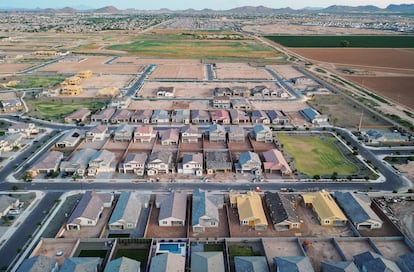Buying a home in the US has never been this hard
Prices are soaring and the option to buy is receding for millions of tenants nailed by rising rents

The price of rented accommodation in the United States is up 26% since the early 2020s. The number of tenants with unaffordable rents and utilities — those paying 30% or more of their income — is at an all-time high. Half of the nation’s tenants are in this situation because rents have risen more than incomes for decades and the pandemic further complicated the situation, according to an annual report from Harvard’s Joint Center for Housing Studies, which also points out that buying a home is increasingly expensive, preventing millions from climbing onto the property ladder.
Home prices are 47% higher than they were four years ago. Median prices are five times the median household income. In the 1990s, they were just three times higher. Add to this the cost of mortgages with interest rates exceeding 7% and the fact that home insurance that has been rising steadily.
The conclusion drawn by the Harvard think tank is that solving this crisis — in addition to other housing crises regarding the record number of homeless, those in inadequate housing or subject to the threat of climate change — requires the private and non-profit sectors to join forces with the public authorities at all levels of government.
The current scenario has forced those who would like to buy their first home but lack the down payment to hold off. Last May, Treasury Secretary Janet Yellen herself admitted that it is “almost impossible to buy a first home” and Federal Reserve Chairman Jay Powell agreed that the situation has become a “very big challenge.”
Moreover, homeownership barely moved 0.1% in 2023, and currently stands at 65.9% of the population. This is the smallest rise since 2016, nor has there been any progress in reducing the racial disparity in ownership. In the first quarter of the year, the ownership rate among white households was 74% against 49.9% for Hispanics and 46.6% for African Americans.
“Whether it’s high down payments or monthly mortgage payments, the costs of buying a home have put homeownership out of reach for all but the most privileged households,” says Daniel McCue, one of the researchers associated with the Harvard center.
From 2019 to 2022, the number of homeowners facing unaffordable costs has risen by three million, reaching 20 million households. Those bearing the brunt are low-income households and those over 65 who are typically living off pensions.
Why are prices rising?
The lack of supply on the real estate market has triggered price wars. The greatest potential lies in existing homes, but homeowners with mortgages far cheaper than the current rates are not selling, as there is no incentive. As a result, there were only 1.11 million homes for sale in March 2024, down 34% from the same period in 2019, and the housing inventory plummeted in 94 of the 100 largest cities in the U.S. in the first quarter of this year. In 2023, only 4.1 million pre-owned homes were sold, the lowest figure in 30 years.
What other costs are involved in buying a home?
Insurance premiums have risen an average of 21% between May 2022 and May 2023, according to Harvard, in what looks to be an ongoing trend.
Property taxes are also on the rise, taking a toll on landlords. Those who rent their properties saw their operating expenses rise by 7.1% last year, and not just on account of inflation regarding materials and services, but also due to a nationwide insurance hike of 27.7%. This feeds into the general problem. Rising costs, in addition to the rising price of capital, make it very difficult to finance multifamily rental developments. Naturally, this lack of supply also has a knock-on effect on rental prices for tenants.
Sign up for our weekly newsletter to get more English-language news coverage from EL PAÍS USA Edition
Tu suscripción se está usando en otro dispositivo
¿Quieres añadir otro usuario a tu suscripción?
Si continúas leyendo en este dispositivo, no se podrá leer en el otro.
FlechaTu suscripción se está usando en otro dispositivo y solo puedes acceder a EL PAÍS desde un dispositivo a la vez.
Si quieres compartir tu cuenta, cambia tu suscripción a la modalidad Premium, así podrás añadir otro usuario. Cada uno accederá con su propia cuenta de email, lo que os permitirá personalizar vuestra experiencia en EL PAÍS.
¿Tienes una suscripción de empresa? Accede aquí para contratar más cuentas.
En el caso de no saber quién está usando tu cuenta, te recomendamos cambiar tu contraseña aquí.
Si decides continuar compartiendo tu cuenta, este mensaje se mostrará en tu dispositivo y en el de la otra persona que está usando tu cuenta de forma indefinida, afectando a tu experiencia de lectura. Puedes consultar aquí los términos y condiciones de la suscripción digital.
More information
Archived In
Últimas noticias
David Bowie, the galactic thinker who encouraged us to break new ground
John Berger and the loss of rural culture
From police officer to bloodthirsty kidnapper: Terror in Mexico during the years of ‘The Ear Chopper’
Alain Aspect, Nobel laureate in physics: ‘Einstein was so smart that he would have had to recognize quantum entanglement’
Most viewed
- David King, chemist: ‘There are scientists studying how to cool the planet; nobody should stop these experiments from happening’
- Reinhard Genzel, Nobel laureate in physics: ‘One-minute videos will never give you the truth’
- Oona Chaplin: ‘I told James Cameron that I was living in a treehouse and starting a permaculture project with a friend’
- Mexico completes its trade shift with the entry into force of tariffs on China and countries without trade agreements
- Sinaloa Cartel war is taking its toll on Los Chapitos











































